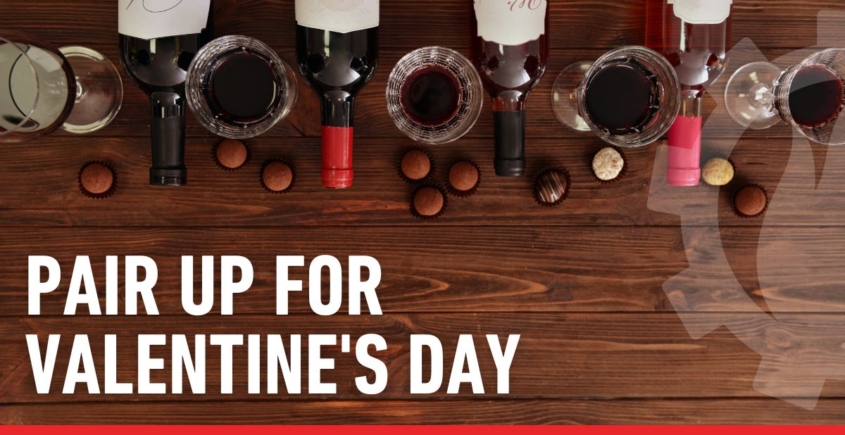Pair Up for Valentine’s Day
Ok, so today’s a big day in February – Valentine’s Day – a time for a bit of flirting, quiet time, and love with your significant other. If you are reading this, and STILL have not purchased a gift – here’s a quick and wonderful idea you can do on your way home – a thoughtful bottle of wine paired with the proper chocolates. Whether your preference is a big bold red with dark chocolate, champagne with white chocolates, or tasty port and hazelnuts, I’ve got you covered. So, enjoy a bit of trivia below to get you motivated and then go find the combo that’s right for you. And, if you want to really make it special, instead of going out for dinner, bring home the chocolates and wine with you as you expertly, or in my case not so expertly, prepare a wonderful dinner for my amazing wife. Thanks to Google, wineenthusiast.com, and YouTube for the insights and links. ENJOY!!

By popular demand, we’re now sharing guides for the previous week’s logo contest!
Every Friday, scroll to the bottom of the post to review last week’s guide and see if we managed to stump you.
- Wine has been associated with romance and celebrations since ancient times. The Greeks worshipped Dionysus, the god of wine and festivity, while the Romans honored Bacchus in similar celebrations of love and pleasure.
- In the Middle Ages, wine was often shared during courtship as a symbol of refinement and passion.
- Red wine contains resveratrol, an antioxidant that may improve circulation and boost heart health, contributing to its reputation as an aphrodisiac.
- Chocolate has been linked to love and desire for centuries. The Aztecs believed cacao was a gift from Quetzalcoatl, their god of wisdom, and consumed it to increase vitality and virility.
- Chocolate contains phenylethylamine (PEA), a compound known to stimulate feelings of excitement and happiness, similar to the feeling of being in love.
- When European explorers brought chocolate to Spain in the 16th century, it quickly became a luxurious treat reserved for the aristocracy, often given as a romantic gift.
- Valentine’s Day is rooted in the feast of Saint Valentine, celebrated since the 5th century. By the 18th century, exchanging tokens of affection, including sweets and wine, became common in England and France.
- Richard Cadbury popularized the heart-shaped box of chocolates in the 1860s, making it a quintessential Valentine’s Day gift. (I can remember getting little boxes from my parents as a kid)
- Romantic dinners featuring wine pairings with chocolates or other sweet treats became a tradition as fine dining experiences gained popularity in the 20th century.
- Some exclusive wine and chocolate pairings can cost thousands of dollars. For instance, a pairing of rare vintage Madeira and handcrafted truffles can be a lavish luxury. Just a quick FYI – not for Jackie and me!!
- In Portugal, pairing Ruby or Tawny Port with chocolate is a long-standing tradition, symbolizing indulgence and celebration.
- In Japan, women traditionally give chocolate to men on Valentine’s Day. There are even different types of chocolates: “Giri-choco” for friends and colleagues and “Honmei-choco” for romantic partners.
Pairings:
Cabernet Sauvignon & Dark Chocolate with Sea Salt
- Wine: A bold Cabernet Sauvignon (e.g., from Napa Valley or Bordeaux)
- Chocolate: 70% dark chocolate with sea salt
- Why it Works: The rich tannins in the wine balance the bitterness of dark chocolate, while the salt enhances the wine’s fruit flavors.
Pinot Noir & Milk Chocolate Truffles
- Wine: A silky Pinot Noir (e.g., from Burgundy or Oregon)
- Chocolate: Creamy milk chocolate truffles
- Why it Works: Pinot Noir’s red berry notes complement the smoothness of milk chocolate, creating a velvety pairing.
Zinfandel & Dark Chocolate with Cherries
- Wine: A jammy Zinfandel (e.g., from California)
- Chocolate: Dark chocolate with dried cherries
- Why it Works: The fruit-forward profile of Zinfandel highlights the sweetness of cherries and cocoa flavors.
Champagne or Sparkling Wine & White Chocolate
- Wine: Brut Champagne or Prosecco
- Chocolate: White chocolate with vanilla or lemon zest
- Why it Works: The acidity and bubbles in sparkling wine balance the creamy sweetness of white chocolate.
Merlot & Chocolate-Covered Caramels
- Wine: A soft, fruity Merlot (e.g., from Washington State or Bordeaux)
- Chocolate: Milk or dark chocolate-covered caramels
- Why it Works: Merlot’s plum and mocha notes pair beautifully with the sweetness of caramel.
If you experience a great pairing of your own, please share: skowalski@khtheat.com
How did you do on last week’s logo contest?
Check out our logo guide for the “Super Snackin'” post here!






Leave a Reply
Want to join the discussion?Feel free to contribute!